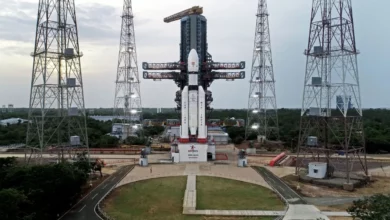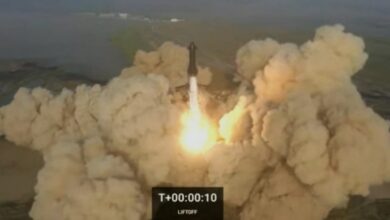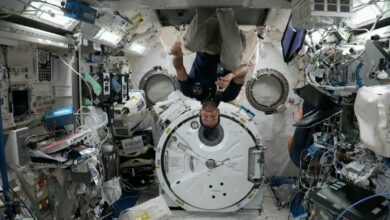
SpaceX’s Falcon Heavy rocket, the towering launch vehicle known for its boosters’ aerial acrobatics and synchronized landings when returning to Earth, took to the skies Sunday, delivering national security payloads to orbit for the US military.
The mission, called USSF-67, took off at 5:56 p.m. ET from Kennedy Space Center in Florida, marking the fifth successful flight of the rocket recently dethroned as the world’s most powerful operational launch vehicle. This mission was initially advertised to launch on Saturday, and the reason for the one-day delay was not immediately clear.
The Falcon Heavy debuted to much fanfare in 2018 when SpaceX CEO Elon Musk attached his personal Tesla Roadster as a test payload on the launch. The car is still in space, taking an oblong path around the sun that swings out as far as Mars’ orbital path.
The rocket followed up that test mission with two launches in 2019 before taking a three-year hiatus; the vast majority of SpaceX’s missions don’t require the Falcon Heavy’s amped-up power. On the other hand, SpaceX’s workhorse Falcon 9 rocket launched more than 60 times in 2022 alone, sending two groups of astronauts to space as well as Starlink satellites and a variety of other spacecraft.
But SpaceX is now making good on lucrative military launch contracts it signed for the Falcon Heavy years ago. The rocket returned to flight in November with the launch of the US military’s USSF-44 mission, and Sunday’s liftoff was a follow-up to that display.
“USSF-44 included six payloads on one satellite that advance communications, space weather sensing, and other technologies into near-geosynchronous orbits,” according to the military’s Space Operations Command.
And USSF-67 will make use of the same type of spacecraft deployed on USSF-44, called LDPE, which is essentially a bus for outer space that can carry smaller satellites. The Falcon Heavy also carried a communications satellite, called the Continuous Broadcast Augmenting SATCOM, for the US Space Force.
Additional details about the satellites on Sunday’s mission were not immediately available.
With each launch, the Falcon Heavy rocket puts on a dramatic show back on Earth.
After Sunday’s mission, the company recovered two of the Falcon Heavy rocket’s first-stage boosters — the tall white sticks strapped together to give the rocket its heightened power at liftoff. After expending most of their fuel, the side boosters fell away from the center core and reoriented themselves to slice back through the Earth’s atmosphere.
As they approached the ground, the boosters reignited their engines and completed a synchronized landing on ground pads near the Florida coastline. It’s a signature move for SpaceX, which routinely recovers and reuses its rocket boosters to drive down the cost of launches.
SpaceX did not attempt to recover the center booster because of fuel requirements.
The company hasn’t successfully retrieved all three boosters yet, although it’s come close. The two side boosters made a pinpoint, synchronized landing on ground pads after an April 2019 mission, and the rocket’s center booster touched down on a seafaring platform. But rough waves toppled it over.
All about this rocket
For years, the Falcon Heavy was the world’s most powerful operational rocket. But in November, NASA’s new moon rocket, called Space Launch System, or SLS, stole that title with its inaugural launch. SLS launched the uncrewed Artemis 1 mission around the moon, paving the way for future missions with astronauts on board.
While the Falcon Heavy gives off about 5 million pounds of thrust, SLS is puts out as much as 8.8 million pounds of thrust — 15% more than the Saturn V rockets that powered the Apollo moon landings.
At its experimental facilities in South Texas, SpaceX is in the final stages of preparing for the first orbital launch attempt of its Starship spacecraft and Super Heavy rocket. Though the test flight still awaits final approval from federal regulators, it could lift off in the coming weeks.
If successful, SpaceX’s Starship would dethrone the SLS as the most powerful rocket flying today.
The Starship system is expected to outpower both SLS and Falcon Heavy. The forthcoming Super Heavy booster, which is designed to vault the Starship spacecraft into space, is expected to put off about 17 million pounds of thrust.
It’s not all a competition, however. Both the SLS rocket and SpaceX’s Starship are integral to NASA’s plans to return astronauts to the moon’s surface for the first time in half a century.
SpaceX has its own, ambitious vision for the Starship: ferrying humans and cargo to Mars in hopes of one day establishing a permanent human settlement there.




